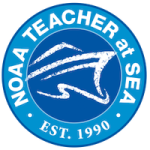Our Mission
To establish scientific partnerships between schools around the world and engage students in activities and communication about ocean science.
What is a Drifter?
- A drifter, or drifting buoy, is a piece of scientific equipment that measures sea surface temperature, but most are also equipped to measure other variables. As the drifter moves around, guided by ocean currents, measurements of atmospheric pressure, winds, wave height, and salinity can be taken. This data is collected by sensors in the drifter and transmitted to overhead satellites. Tracking the location of drifters over time allows scientists to build a profile of ocean currents.
-
A drifter’s drogue, also known as a sea anchor, extends 20 meters (or 65 feet) deep and is designed to move with the near-surface ocean currents. The drogue and surface float move together, connected by a long tether. Without a drogue, the drifter will be transported by wind and waves, much as a ping pong ball or beach ball is pushed across the surface of a pool.
NOAA SciJinks Web Game
The Adopt a Drifter Program’s (ADP) first summer intern, Stephen Lewis, designed and developed “Ocean Odyssey: Tracking Marine Debris”, a NOAA SciJinks web game suitable for K-12 audiences! Ocean Odyssey is inspired by the Global Drifter Program’s contribution to ocean surface current observations. The game incorporates historic drifter data and helps middle school audiences understand how ocean surface currents transport marine debris and how users can help keep our oceans clean.
The new SciJinks game is the latest addition to the ADP’s growing list of resources for educators. Teachers can now introduce the topic of ocean surface currents and marine debris in an informative and fun manner. To read more about Stephen’s experience during the summer, click here. The internship was a collaborative effort across several NOAA programs, including GOMO, GDP, ADP, and SciJinks.
Teacher at Sea

Comment start We encourage you to visit the Teacher at Sea homepage linked below. The Teacher at Sea program allows full-time educators to join NOAA scientists on research cruises and gain first-hand experience working at sea. The program is free for educators; the yearly application window opens November 1st with applications due November 30th.” Comment en
We encourage you to visit the Teacher at Sea homepage using the button below. The Teacher at Sea program allows full-time educators to join NOAA scientists on research cruises and gain first-hand experience working at sea. The program is free for educators! To apply, you must complete the online application that opens November 1st and submit your application within the 30-day window.

